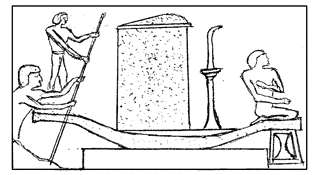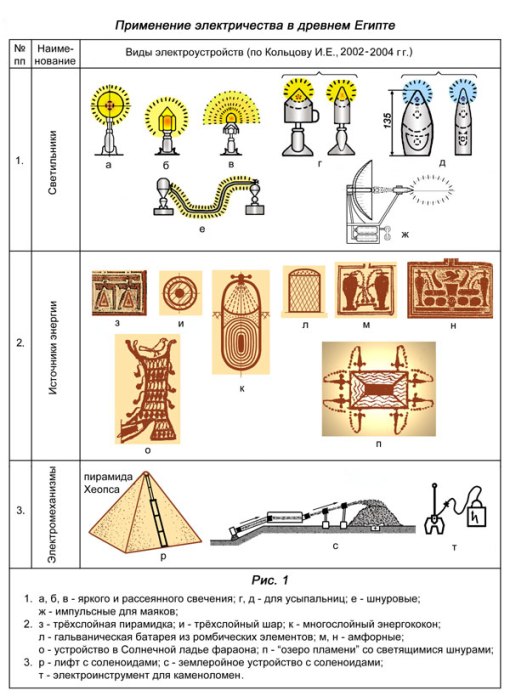Categories: Interesting Facts, Controversial issues
Number of views: 30911
Comments on the article: 4
Electricity in Ancient Egypt
 Despite the centuries-old study of the history of Egypt for modern man, the secrets of ancient civilization and its knowledge remain unsolved.
Despite the centuries-old study of the history of Egypt for modern man, the secrets of ancient civilization and its knowledge remain unsolved.
Greek historian Herodotus (484-425 B.C.) in 450 B.C. visited Egypt, passing from the mouth of the Nile to the island of Elephantine at Aswan. He was admired by the hardworking God-fearing and talented people, as well as huge palaces, including one that included three thousand underground and ground premises. It surpassed all known Hellenic structures in size. The labyrinth was built on the shores of Lake Meridov near the modern city of El Fayyum and Kayyum Lake, which was also built by people. Herodotus considered this building a miracle of the world, as well as the canal between Meridian Lake and the Nile. They were built around 1850 BC. King Senusort III.
The book "The Journey of Pythagoras", published in St. Petersburg at the beginning of the 20th century, tells about his journey to Egypt. The priest of Isis first led him through many difficult turns with his eyes closed, going down to the bottom of a spacious well, and from there into the labyrinths illuminated by light that was sufficient for reading and reflection. Here he saw many scientific things.
In the XVII century. Serano de Bergerac in his book “Journey to the Sun” wrote about unusual physical concepts of antiquity, including electricity: “Imagine that in ancient times people knew well about the little two suns, how to use them. They were called burning lamps, which were used only in the magnificent tombs of great people. ” Serano reports that electricity is generated by the struggle of heat and cold (the "fiery beast of the forest" and the "ice beast"). At the end of the battle, accompanied by thunderous blows, the “fiery beast” lights up its eyes, which feed on the light of this battle. For a modern person, such an explanation is not entirely clear. There are a number of other authoritative sources that testify to the existence of electricity in ancient Egypt.
Exploring the heritage of ancient Egypt in drawings of temples, tombs, on stone slabs, in texts, etc., you can see the mysterious technical devices that they owned, information about which was transmitted to descendants.
Among them are: lamps, sources of static energy, as well as mechanisms that use this energy to perform labor-intensive work.
All material bodies have electrostatic radiation of different strengths. The most powerful of them were used by ancient civilizations.
From ancient written sources and chronicles it is known that in Egypt (and other countries) there were "eternal lamps" that cannot be extinguished by water and wind. They were used in temples, palaces, libraries ...
1. Lamps had both individual and collective energy sources. From the lamps emitted an external, not an internal glow. The term of their luminescence in the temples was estimated in hundreds of years. If necessary, a special cap was put on the lamp to obtain soft uniform light. On Alexandria lighthouse BC there were small-sized lamps, the light of which was visible for 60 kilometers. There was also a device with a pulsed flash for operation in fog and bad weather on this lighthouse (see Fig. 1g at the end of the article). To work in cramped underground conditions, portable lamps with luminous cords of many meters length were used (1e). Known fixtures with flexible luminous cords operating from a collective source.
In the XVI-XVII centuries, archaeologists discovered lamps in the tombs of Egypt (and other countries) that illuminated the room for more than 1600 years with a faint light of pastel colors (1d, d).
2. Sources of static electricity were various devices.These included three-layer pyramids and balls; multilayer energy windows; amphora devices; galvanic batteries from rhombic elements like sunflower seeds. It is interesting that in the bow of the Pharaohs' Solar Rooks there were galvanic batteries that created an energy dome above the rook and a vertical energy flow above it. In the drawings of the rooks even the direction of the energy flows from the batteries is indicated (see the article “Energy devices of the“ Solar Rooks of the Pharaohs ”).
The collective source of energy for cord luminaires is a four-section tank with liquid solutions (“Lake of Flames”, 2p). There were other energy sources in Egypt for use in industrial machinery.
3. It is known that an inclined elevator with electric solenoids was installed on the eastern side of the Cheops pyramid, through which heavy stone blocks were delivered up to the construction site to a height of 90 meters. Due to the insufficient capacity of the elevator, over 90 m delivered small stone, from which blocks of the right size were cast in molds. (See Art. "On the construction of the Pyramid of Cheops.")
At the same time, Egypt also had an excavation device for digging canals, pits for large construction projects, for filling shafts, barrows. This device also used coaxially mounted solenoids, which threw the earth to the side for many tens of meters (see Art. Power Tools in Quarries of Egypt, Riddles of the Zmiev Shafts).
A similar electro-solenoid system was proposed by K. Tsiolkovsky. and other scientists to launch rockets into space, to other planets. Even its creation in metal was conducted.
In the quarries of Egypt, the preparation of stone blocks and obelisks was carried out using power tools and pulsed discharges, which had interchangeable tips. The same tools were used for their final processing. Ancient lamps and other devices gather dust somewhere in the storerooms of museums or at private individuals. Often the source of energy was available materials.

See also at bgv.electricianexp.com
:
